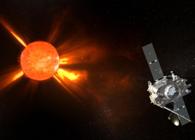Here comes the Sun

One of the STEREO craft and the Sun.
10 February 2011
STEREO gives first image of the whole of the Sun
A major milestone in the study of the Sun was reached on Sunday 6th February, when the two identical spacecraft that make up NASA’s STEREO mission provided images of all the Sun for the first time.
Launched in October 2006, the two STEREO spacecraft have been gradually moving away from the Earth in opposite directions and on Sunday reached a point where they were orbiting the Sun on opposite sides, 180 degrees apart.
The event has been closely monitored by the Solar System Physics Group at Aberystwyth University’s Institute of Mathematics and Physics who study the solar wind and the Sun’s effect on the Earth.
It was this group, working with Aberystwyth University's spinout company See3D, which generated the world’s very first 3-D images of the Sun in 2007, using data from STEREO.
Dr Andy Breen and colleagues at the Solar System Physics Group are interested in the Heliospheric Imagers on board the STEREO spacecraft.
“For the very first time we will be able to see the whole of the Sun at the same time. It will give us a new perspective on activity on the Sun, particularly the solar eruptions which can launch coronal mass ejections.”
“These ejections are massive bursts of material moving out through the solar wind. If they strike the Earth they can knock out satellites, distort the accuracy of GPS systems, and even cause power grids to fail in extreme conditions. It is the interaction of disturbances in the solar wind with the Earth’s magnetic field that causes the spectacular phenomenon of the Northern Lights or Aurora Borealis.”
“Until now, the longest we have been able to monitor one event on the surface of the Sun is 14 days. Now that we can see the whole of the Sun all of the time we will be able to follow an active region from the moment it forms, see how it evolves, and then ultimately dies.”
Dr Breen hopes that the images provided by STEREO will enable scientists to better predict what the Sun is going to do and how it might affect the Earth.
Dr Breen also argues that understanding what is happening on the surface of the Sun has become more pressing recently, as there is evidence to suggest that it is changing into a different mode.
“Research seems to indicate that the Sun spends around a quarter of its time in low activity - (where there are few Coronal Mass Ejections) and a smaller proportion of its life in Grand Maximum mode, where the average level of activity is unusually high. For the past half a century, since the 1950s, activity levels have been unusually high and most of the data we have has been collected during this time, much of it since the first space mission in 1956.”
“It now appears that we are coming out of this phase so the information provided by STEREO will be invaluable as we learn more about this new quiet phase.”
However, Dr Breen stresses that entering a quiet phase is no guarantee of safety from solar storms. He notes that the biggest solar storm ever recorded, the Carrington storm of 1859, happened during a quiet phase. Such was its intensity that it knocked out the US telegraph network and heated rail lines causing trains to derail, and meant that the Aurora Borealis was visible in the skies above Bombay and the West Indies.
Dr Breen believes that a similar solar storm today would have far reaching consequences, causing significant damage to GPS, communication systems, and would be a high risk to electricity supplies.
Dr Mario Bisi, another member of the Solar System Physics Group, published an article in the Solar Physics journal during 2010 which was the most-comprehensive study of a coronal mass ejection to date. Dr Bisi tracked the 13th May 2005 coronal mass ejection all the way from the solar surface to the Earth and looked at how it interacted with the solar wind along the way, and at the way it also interacted with the Earth and the effects it had on our planet.
Dr. Bisi believes that by employing the many techniques used in his study along with STEREO and some of the other new and upcoming space-based and ground-based technologies and instrumentation, then such studies in the future can become even more comprehensive and thus allow us to delve further into the fundamental science of what it is that makes our Sun ‘tick’.
AU2911



